|
MobileDemand xTablet T1400
Thin and light Intel "Bay Trail" quad-core powered rugged tablet with full 1920 x 1200 pixel capacitive sunlight-viewable display
by Conrad H. Blickenstorfer
In April 2014, MobileDemand announced the xTablet T1400 as the first in a series of thin and light rugged tablets the company said it will introduce in 2014. The xTablet T1400 is designed for workforce functions found in fields such as utilities, field service, public safety, field sales, delivery and transportation. In this article we're taking a detailed look at MobileDemand's initial "thin-and-light."
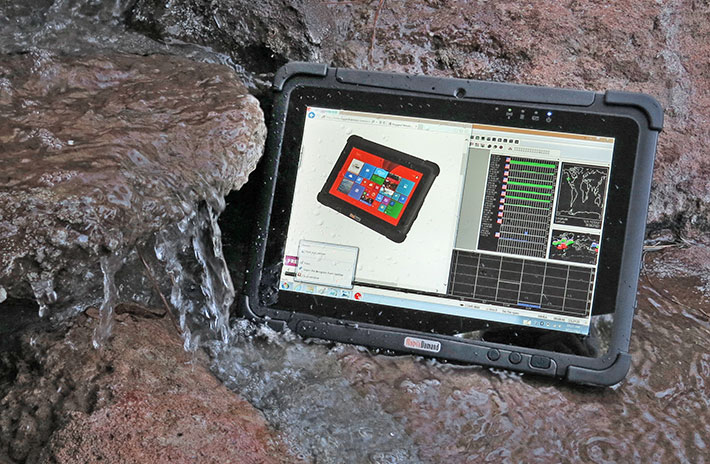
We should say right upfront that the MobileDemand xTablet T1400 is a superb example how very far rugged computing hardware has advanced over the past few years. The table below shows some comparison specs between the new T1400, and MobileDemand's flagship back in 2007, the xTablet T8700. The T8700 was a mature, third or fourth generation tablet that represented the very best in rugged Tablet PC technology just seven years ago.
|
2014 vs 2007
|
MobileDemand
|
MobileDemand
|
|
Model
|
xTablet T1400
|
xTablet T8700
|
|
|

|
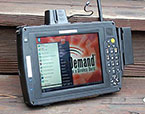
|
|
Year
|
2014
|
2007
|
|
Size
|
10.8 x 7.8 x 0.7 inches
|
10.6 x 7.2 x 1.65 inches
|
|
Volume
|
58 cubic inches
|
126 cubic inches
|
|
Weight
|
2.4 pounds
|
4.6 pounds
|
|
Display
|
10.1-inch, 1920 x 1200 pixel
|
8.4-inch, 800 x 600 pixel
|
|
Display area
|
46.8 in2
|
33.2 in2
|
|
Display brightness
|
700 nits
|
300 nits
|
|
Sealing
|
IP65
|
IP54
|
|
Processor
|
1.86GHz Intel Celeron N2920
|
1.2GHz Intel Core Duo U2500
|
|
Processor TDP
|
4.5 watts
|
10 watts
|
|
Overall PassMark
|
1,060
|
310
|
|
Overall CrystalMark
|
114,000
|
41,000
|
|
Operating temperature
|
-4° to 140° Fahrenheit
|
-4° to 122° Fahrenheit
|
|
Battery/Battery Life
|
78 watt-hour/"12 hours"
|
77 watt-hour/"5 - 7 hours"
|
How much progress has there been? The new machine weighs just over half as much as the old one and occupies less than half the volume, yet its screen has 40% more display area and almost 5 times as many pixel for a much, much sharper picture. The display is also more than twice as bright. And although the new machine's offers almost three times the benchmark performance of the old flagship, its efficient Intel N2920 processor operates at less than half the heat dissipation of the older machine's chip.
One could well argue that the new xTablet T1400 is designed to be a "thin & light" and thus not in the same ruggedness class as the hefty old T8700, and in some respects that's true. However, the much lighter new tablet actually has a wider operating temperature range and significantly better environmental sealing (IP65 instead of IP54). To be fair, the old T8700 was built like a tank, but the available ruggedness numbers favor the new and lighter T1400. And also note that the official successor to the old xTablet T8700 is MobileDemand's heavy-duty xTablet T1200.
Thin and light: Since MobileDemand emphasizes "thin and light," what exactly does this mean with respect to a tablet like their T1400? Well, as a rule of thumb, traditional fully rugged tablets have weighed between 4.5 and 6 pounds for many years, with their size and weight determined by the size of components such as disks, fans, batteries, etc., as much as by their rugged construction.
The "tablet revolution" started by the Apple iPad in April 2010 changed all that. When enterprise and vertical market customers wanted more ruggedness than the iPad and its copies provided, they insisted on the same large display, the same look and feel, and tablets as thin and light as possible. The original iPad weighed 1.5 pounds, the latest iPad Air no more than a pound. That's not possible in a ruggedized tablet, but the xTablet T1400's 2.4 pounds and slender 0.7 inch profile is close enough for most rugged device customers.
The xTablet T1400 platform
With the xTablet T1400, MobileDemand is providing a state-of-the-art rugged tablet capable of running standard enterprise Windows 7 or 8.1 with all of their security and device management features. It is also an advanced design that is on par with, or even ahead of, what's available in the consumer media tablet space, sporting a high resolution display with almost three times the number of pixels as the old XGA standard, projected capacitive multi-touch, and quad-core processing performance.
The picture below shows, in accurate scale, the xTablet T1400 (left), the fully rugged xTablet T1200 with its 10.4-inch display in the center, and the older T7200 (right) that has a wide-format 7-inch screen.

Some additional commentary about size and design features in rugged tablets, and how they differ from consumer products:
First, the current trend in consumer tablets to make them as slender as possible is questionable as it increases the cost of design and components, and most customers stick the sliver-thin tablets into a bulky case anyway. Rugged tablet design is different. They need to be rugged even without a case, hence the more durable materials and protective corner bumpers seen in most designs, including the T1400.
Second, physical controls remain popular in many rugged tablets. The physical keypads of MobileDemand's fully rugged tablets make it easier to rapidly enter data under any environmental conditions. And note that capacitive touch — which enables the effortless and elegant tapping, panning and zooming introduced by the iPhone and iPad — requires a smooth glass surfaces that extends well beyond the actual LCD. That is a bit of a challenge in ruggedized designs that use an elevated protective bezel for extra protection, generally making for a slightly larger footprint than consumer tablet designs.
The extra thickness of a ruggedized tablet compared to a consumer tablet is mandated by a) the more substantial housing and extra protection of bumpers, and b) by integration of industrial grade components (like the T1400's dedicated scanner) and the presence of more extensive and better protected ports and connectors.
Below is a look at the xTablet T1400 from the front and from all four sides. It's instantly obvious that, for a rugged device, this is a remarkably compact design that easy to transport and carry around, or being mounted in vehicles and other places.
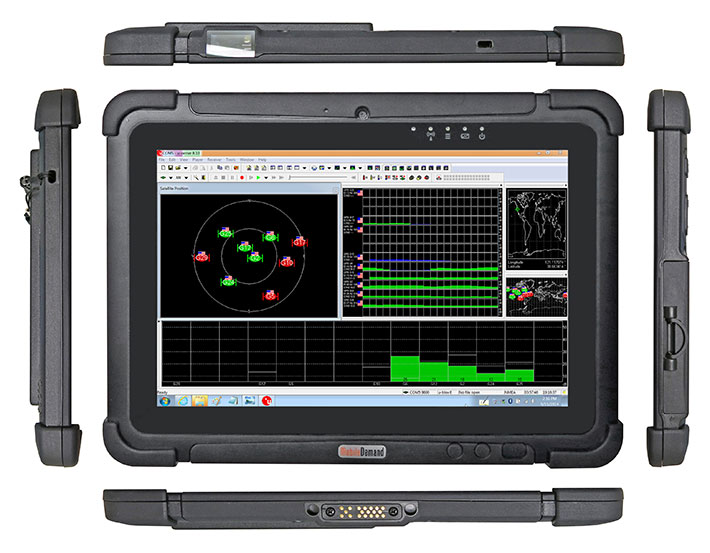
Note that one difference between traditional fully-ruggeds and modern-style thin and lights is that the latter have fewer obvious physical buttons and controls. So no prominent physical keypad, navigation diamond, scanner buttons or volume controls on this tablet. On the xTablet T1400 it's a power button, a Home icon button that brings up the HotTab utility that controls the unique features of the tablet, a single programmable function button, and on the backside another programmable button and volume control, all discretely integrated into the back housing.
The below picture shows a close-up of the I/O block on the right side of the xTablet T1400. This block contains all of the T1400's I/O, protected with a single hinged pressure-seal cover with dual sealer lips.

From left to right, there is the power jack, the audio jack, a full-size USB 3.0 port (you can always tell 3.0 because it's blue), a special adapter port that provides Ethernet and RS232 serial, below it a micro-SD Card reader, and then a micro-HDMI port.
The top of the unit shows a plastic cover with a window for the optional integrated Intermec EA31 high performance imager 2D CMOS imager (see EA31 product page). MobileDemand emphasizes the performance, low power draw, and lack of laser issues of the EA31 for those who may be concerned about the use of lasers for scanning.
Intel "Bay Trail" processor
Computing power comes from a 1.86GHz quad-core Intel Celeron N2920 processor that belongs to Intel's next-gen "Bay Trail" platform. Bay Trail CPU architecture employs 22nm process technology and is a major advance in Atom microprocessor design, the first since the platform arrived a few years ago.  There's also turbo boost, and the clever power-saving "active idle" feature from Haswell core processors is there as well. That means much better performance than was available from any prior Atom-based products. For full N2920 specs, see Intel's N2920 product sheet here. There's also turbo boost, and the clever power-saving "active idle" feature from Haswell core processors is there as well. That means much better performance than was available from any prior Atom-based products. For full N2920 specs, see Intel's N2920 product sheet here.
|
PassMark 6.1
|
MobileDemand
|
MobileDemand
|
|
Model
|
xTablet T1400
|
xTablet T1400
|
|
OS
|
Win 8.1 (64-bit)
|
Win 7 (64-bit)
|
|
Processor Type
|
Intel Celeron
|
Intel Celeron
|
|
Processor Model
|
N2920
|
N2920
|
|
CPU Speed
|
1.86Hz
|
1.86Hz
|
|
Max Turbo Speed
|
2.00Hz
|
2.00Hz
|
|
Thermal Design Power (TDP)
|
4.5 watts
|
4.5 watts
|
|
CPU Mark
|
2,014.7
|
2,000.6
|
|
2D Graphics Mark
|
153.1
|
167.8
|
|
Memory Mark
|
409.9
|
426.1
|
|
Disk Mark
|
2,048.3
|
2,050.6
|
|
3D Graphics Mark
|
115.3
|
100.7
|
|
Overall PassMark
|
1,062.7
|
1,062.6
|
|
CrystalMark
|
|
|
|
ALU
|
26,714
|
27,895
|
|
FPU
|
22,541
|
22,405
|
|
MEM
|
16,411
|
17,610
|
|
HDD
|
36,655
|
36,898
|
|
GDI
|
4,816
|
5,359
|
|
D2D
|
3,335
|
1,380
|
|
OGL
|
3,207
|
3,310
|
|
Overall CrystalMark
|
113,679
|
114,857
|
Bay Trail represents a departure from Intel's product strategy of the past few years that differentiated between low end (Atom) and high end (Core) processors. Instead, Bay Trail consists of a large family of single, dual, and quad processor chips optimized for various types of devices. Lower end Bay Trail processors use Intel's "Atom" brand, whereas higher end versions targeting tablets, notebooks and desktops carry Intel's "Celeron" (as evidenced by the T1400's Celeron-branded N2920 processor) and even "Pentium" brand names.
Also note that for the first time an Intel Atom microprocessor architecture is paired with genuine Intel graphics. The graphics cores integrated into Bay Trail systems are of the same HD 4000 architecture and variety as those used in Intel's 3rd generation "Ivy Bridge" processors, albeit with fewer execution units (four instead of several times that number) and lower clock speeds. Still, the new graphics support most of the same APIs and features, including DirectX 11, OpenGL 4.0, and OpenCL 1.2.
With the xTablet T1400, MobileDemand is providing a state-of-the-art rugged tablet capable of running standard enterprise Windows 7 or 8.1 with all of their security and device management features. Our tester had both installed. Upon cold start, the xTablet T1400 showed the "flat" new Windows logo, then asked whether to boot into Windows 7 or Windows 8.1. We did our software benchmark testing both in Windows 7 and Windows 8.1, to see if there's a difference. As the above tablet shows, whatever performance variations there are between the two OS versions are negligible.
A look inside
Can a "thin and light" tablet still be ruggedly built? It can, though there may be some concessions due to lower size and weight. We described MobileDemand's fully-rugged magnesium alloy xTablet 1200 as "solid as a rock." A device like the xTablet T1400 that weighs less than half as much and is less than half as thick will not provide that same degree of subjective solidity, but if carefully design and manufactured, it can still hold up to a lot of abuse.
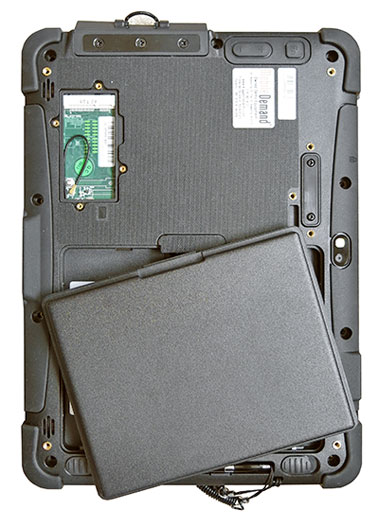 The xTablet T1400's case is made of PC+ABS TPR, a blend of polycarbonate with its high heat and impact resistance, and ABS (Acrylonitrile Butadiene Styrene) which is a rubber-polymer blend, combining for a very strong, light material well suited for thin-wall molding (see here and here). TPR stands for ThermoPlastic Rubber and presumably refers to the rubber overmoldings on the T1400's case (see here). The xTablet T1400's case is made of PC+ABS TPR, a blend of polycarbonate with its high heat and impact resistance, and ABS (Acrylonitrile Butadiene Styrene) which is a rubber-polymer blend, combining for a very strong, light material well suited for thin-wall molding (see here and here). TPR stands for ThermoPlastic Rubber and presumably refers to the rubber overmoldings on the T1400's case (see here).
The picture to the right shows the backside of the xTablet T1400 with the battery removed from its compartment and placed on top of the tablet. One of the issues MobileDemand had to face was that the very slim profile of the tablet only allowed a 39 watt-hour standard battery, not enough for some of their customers who are looking for 10-12 hours of operation, and so they offer an optional long-life battery with twice that capacity, 78 watt-hours. The flipside is that this powerful battery protrudes about a quarter of an inch and adds some weight, about seven ounces compared to the base battery. If that's not enough, MobileDemand says it will offer a 109 watt-hour XL battery in the future.
Note that as is the case in many ruggedized tablets, the battery compartment is technically outside of the tablet housing. The battery then fits into that compartment where it is secured in place with a friction slider and an additional lock slider. The contacts of the battery have a watertight seal so that no liquid can enter into the interior of the tablet. Which means that whenever the battery is removed or replaced, users must make certain that the seal is intact and free of any debris, and that the lips on the plastic enclosure of the batteries are similarly intact. Also of note is that the xTablet T1400 has a small bridge battery inside, which means the main battery can be replaced with a fresh one without shutting down the computer.
In terms of construction, the xTablet T1400 housing consists of two halves, with the front one holding the LCD and the back one almost all electronics. Fully rugged devices often use an interior magnesium chassis whereas in the thin-and-light T1400 all circuit boards and other components are mounted directly onto the polymer halves. There is, however, a thin aluminum plate that appears to serve both as structure as well as heat sink.
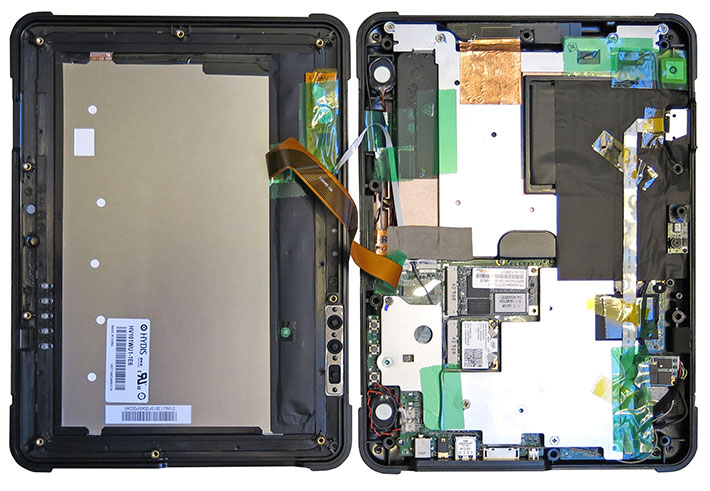
The two halves are held together by ten screws, and they can easily be separated without fear of breaking off clips. There are only two flat ribbon cables between the two halves, and they are long enough to fully open the halves and lay them down, something service personnel will appreciate. For sealing, the two halves employ a tongue-and-groove system that is part of the rubberized plastic protective molding that seems overmolded onto the plastic case halves.
There is plenty of transparent green and yellow tape and black opaque tape to secure things and also to keep components from making contact with the metal frame. Several connectors are secured with a drop of white silicon glue so they won't rattle loose.
Note the two internal PCIe slots, one full-size and one half-size. The full size one was occupied in our tester by a Phison 64GB SSD card in our evaluation unit, the half size one has an Intel Centrino Advanced N 6235. For memory and storage, the xTablet T1400 comes with 4GB of DDR3L/1600 RAM, and a speedy 64GB mSATA solid state disk.
And, as is expected in a next-gen tablet, there's a full complement of sensors. An ambient light sensor, G-sensor, gyrometer, and e-Compass are all present and ready for duty in new-era tablet apps and solutions.
Hydis HFFS display technology
Tablet PCs like the xTablet T1400 are going to be used in vehicles, outdoors, and sometimes in direct sunlight. This means they must be viewable and readable under a wide variety of lighting conditions. Outdoor-viewable display technology has come a long way in the last few years, generally using a combination of transmissive LCDs (for vibrant indoor viewing), a variety of optical treatments (for maximizing contrast outdoors), and a strong backlight (to boost contrast as much as possible).
As is, the xTablet T1400 is using a Hydis HFFS display. HFFS stands for High
Performance Field Fringe Switching. HFFS is an evolution of the highly regarded AFFS display technology, a screen design pioneered by Hydis that even years ago differentiated itself by offering a full 180-degree viewing angle from all directions. HFFS further distinguishes itself with higher resolution, transmittance, brightness, excellent outdoor readability and lowered power consumption. The display used in the xTablet T1400 is a Hydis model HV101U1 with a standard brightness of 450 nits, though MobileDemand apparently upped that to 700 nits. Since the HFFS display essentially uses transmissive technology with certain transflective features, the screen is bright and crisp indoors while being amazingly vibrant and readable outdoors.
To see how well it works, we compared the xTablet T1400 with a third generation iPad whose formidable "retina" display is said to have a backlight strength of about 400 nits. Placed side by side outdoors on a bright day in a semi-shaded area, both displays appeared very bright and very vibrant. The iPad's glossy bezel and display surface show strong reflections, and the T1400's surface and bezel have some reflections as well.

The second picture below shows the two devices from an angle. Both displays remain bright and vibrant, with the iPad again showing a bit more screen reflections.

Same situation when the displays are photographed from the other side. Both remain amazingly bright and vibrant.
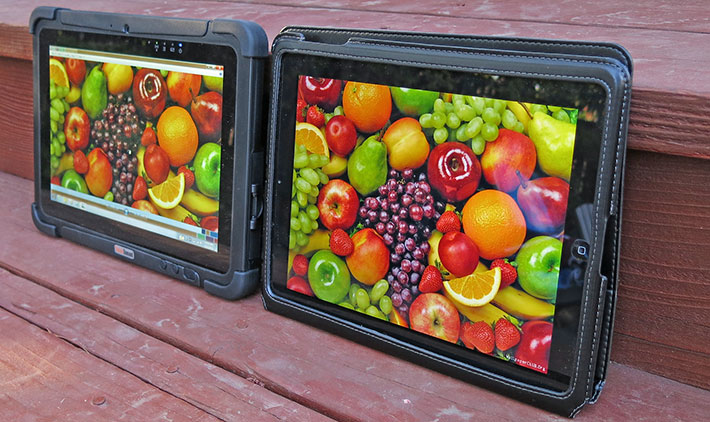
In the next picture, the tablets are placed on the ground, facing the open sky on bright California morning. Both displays are again bright and very vibrant, and both have fairly significant reflections, the iPad again a tad more than the xTablet.
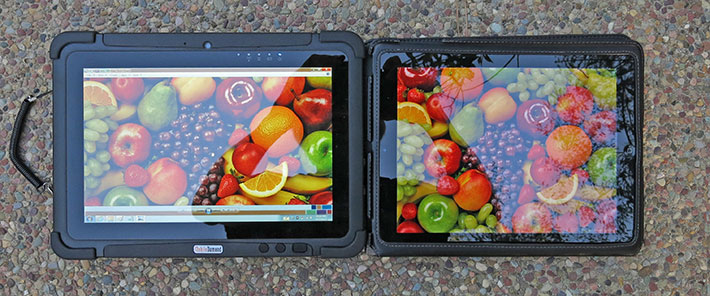
Overall, between the excellent HFFS technology with its perfect viewing angles, total lack of color shifts, and the strong backlight, the xTablet T1400 display can be used pretty much anywhere, even in bright daylight. Like almost all touch screens, however, the display surface of the xTablet T1400 is prone to fingerprints. MobileDemand knows that and uses a field-replaceable glass screen protector glass that guards against direct impacts, and has a coating that decreases fingerprints.
A caveat here: while capacitive multi-touch has become the de-facto standard for smartphones and tablets, legacy Windows with its small check boxes and narrow scrollers was clearly design for use with a mouse. This can, in part, be addressed by optimizing the legacy Windows user interface in Windows 7 (see RuggedPCReview's how-to) or in Windows 8.1 via the Registry Editor (see here). MobileDemand also included a nicely sized metal mesh-tipped stylus that's more durable and works noticeably better than generic broad-tipped capacitive styli.
Another concern is procap operation outdoors where it get bumpy and wet. MobileDemand addresses that, in part, with the screen protector that cause water to bead up, making procap more useable even in wet conditions.
Wireless
For wireless there's dual-band 802.11a/b/g/n WiFi, Class 1 Bluetooth v.4.0, u-Blox Neo-6Q GPS, and optional 4G LTE mobile broadband. WWAN uses a user-accessible micro-PCIe module in a compartment that also has the Micro-SIM card slot. RFID is optionally available as well.
Cameras
The xTablet T1400 has two integrated cameras. The user-facing 2mp camera is for video conferencing, whereas the rear-facing 5mp camera with LED flash can be used for documentation purposes.
Cameras integrated into handheld and tablet computers have historically underperformed compared to even low-end dedicated cameras and, more recently, the cameras available in almost every smartphone. Things have gotten a bit better, but usually not enough to eliminate the need of taking along a dedicated camera or smartphone if photo or video documentation is needed on the job.
As is, the documentation camera in the T1400 is actually quite decent and capable of taking good quality pictures up to 2592 x 1944 resolution. Auto-focus is a bit slow, but once it latches on, images are sharp, and the camera does not compress images so much that they become useless. Video seemed to be limited to standard VGA, but it was sharp and did not lag behind. The camera app, though, only offers very basic functionality.
Below are pictures shot with the T1400 camera in its highest 2592 x 1944 resolution:
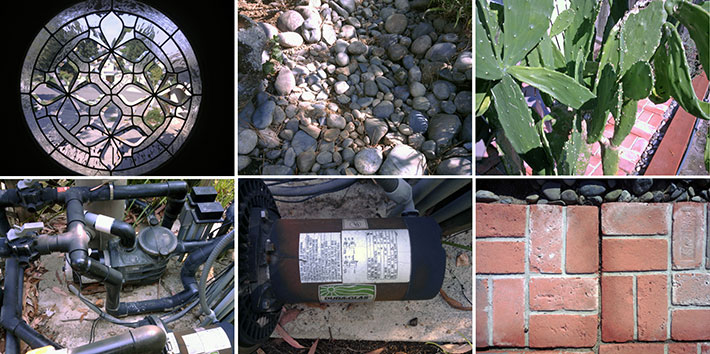
To see full-size originals, click pic1,
pic2,
pic3,
pic4,
pic5,
pic6.
Ruggedness
MobileDemand describes the xTablet T1400 tablet as "rugged" and with its tough PC+ABS case and overmolded TPR corner protection it certainly looks much tougher than all those ever thinner and ever more fragile consumer tablets.
Environmental specs include a very wide -4 to 140 degree Fahrenheit operating temperature range (-20 to 60 degrees Centigrade), which means that as far as temperature goes, the T1400 can be used virtually anywhere.
The tablet can handle 26 repeated drops from four feet per MIL-STD-810G, 516.6 IV to plywood over concrete. That's relevant because four feet is roughly the height a tablet is held while it's being operated when standing or walking.
Sealing is now at the IP65 level. That means the xTablet T1400 is totally protected against dust, and it can also handle low pressure water jets from all directions, albeit with limited ingress permitted. That means that as long as all seals are in good working conditions and the protective door over the I/O block is closed, the T1400 should easily survive even a downpour.
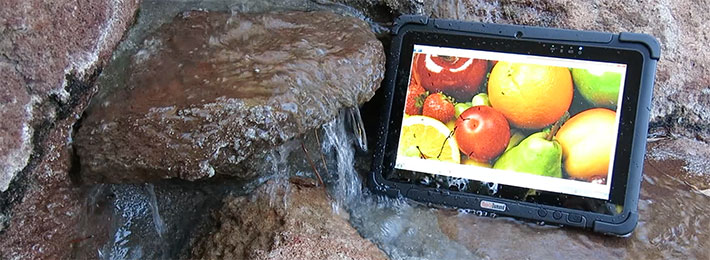
As is, the ruggedness data is a bit sparse considering that the xTablet T1400 is specifically promoted as a thin and light tablet that can hold up to abuse and the elements out there in the field. It would be nice to have additional ruggedness spec if and when they become available.
Bottom line: MobileDemand xTablet T1400
The xTablet T1400 10.1-inch tablet not only considerably expands MobileDemand's product reach from its traditional rugged application areas, it also clearly advances the state-of-the-art with its 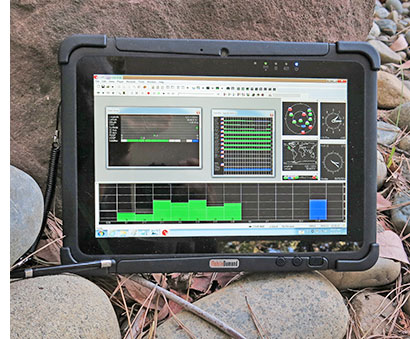 combination of bright, super-high resolution capacitive multitouch display and next-gen "Bay Trail" processor in a thin and light, but sufficiently hardened package that should have great appeal to a wide variety of customers. combination of bright, super-high resolution capacitive multitouch display and next-gen "Bay Trail" processor in a thin and light, but sufficiently hardened package that should have great appeal to a wide variety of customers.
Weighing just 2.4 pounds and being only 0.7 inches thick, MobileDemand's first "thin-and-light" smartly bridges the gap between fully rugged hardware and the sleek but fragile consumer media tablets that are selling in the tens of millions. The combination of a quad-core Intel "Bay Trail" processor and solid state storage yields impressive performance, the kind available only from Intel Core-powered (and more expensive) devices just a couple of years ago.
The xTablet T1400 impresses with an exceptionally sharp, bright and vibrant display that offers high 1920 x 1200 pixel resolution, a perfect viewing angle from all directions, and absolutely no color shifts. Capacitive multi-touch works well with Windows 8.1 and touch-optimized applications, but for Windows 7 and legacy apps, users may wish for an optional active digitizer or a touch controller that works with a narrower pen tip (though, in fairness, MobileDemand's metal mesh capacitive stylus works quite well).
For a thin-and-light tablet the T1400 has good onboard connectivity, including USB 3.0, mini-USB, micro-HDMI, as well as LAN and RS232 serial via adapter. The device has an industrial-grade integrated 1D/2D imager, and also has fairly competent cameras suitable for documentation tasks in a pinch.
Thanks to its PC+ABS construction and protective rubber overmoldings, the xTablet T1400 is quite sturdy and can likely handle a good deal of abuse. IP65 sealing means T1400 users won't have to shy away from rain, and temperaturewise the tablet can handle almost anything. However, we'd like to see more comprehensive ruggedness specs.
Offering good performance, full-shift battery life, a superior hi-res display, and remarkable ruggedness, the fanless xTablet T1400 represents a compelling package for numerous application that requires Windows in the field, but don't need the extra protection (and weight and cost) of a fully rugged device.
Add to that the availability of a powered vehicle dock, a non-powered vehicle dock, an office dock, and a dual-pack charger that works with all three power pack types, and you have a competent, modern tablet that is certain to address the needs of numerous existing and potential customers. -- Conrad H. Blickenstorfer, September 2014
MobileDemand xTablet T1400 Specs:
| Type |
Thin-and-light rugged Tablet PC
|
| Added |
Added 05/2013, full review 09/2014
|
| Processor |
Quad-core Intel Celeron N2920
|
| Processor speed |
1.86GHz, 2.0GHz burst frequency
|
| TDP |
7.5 watts |
| Display Chipset |
Intel HD Graphics |
| OS |
Windows 7 Pro, Windows 8.1 and Pro |
| Memory |
4GB SODIMM DDR3L-1600 |
| Display |
Hydis HV101WU1 HFFS LCD with LED backlight (700 nits) |
| Display size/res |
10.1-inch, 1920 x 1200 HD 178° viewing angle vertical and horizontal |
| Digitizer |
Projected capacitive touch with field-replaceable screen protector, procap pen is included |
| Keyboard |
Optional keyboard mounting kit for vehicle dock |
| Storage |
64GB mSATA MLC solid state disk |
| Expansion slots |
1 x micro-SD card, 1 x SIM |
| Housing |
PC+ABS with rubber bumper corner protection overmolding and briefcase handle that clips on to the MobileDemand hand strap |
| Size |
10.7 x 7.8 x 0.7 inches (272 x 197 x 19mm) |
| Weight |
2.4 lbs. (1.1 kg) in base configuration |
| Operating temperature |
-4° to +140°F (-20° to +60°C) |
| Ingress protection |
IP65
|
| Drop/shock |
4 foot drop |
| Power |
Li-Polymer 7.4V, 5,300mAH, 39.2 watt-hours ("6 hours"); optional Li-Polymer 7.4V, 10,600mAh, 78.4 watt-hours; optional XL Li_polymer 109 watt-hour (future); optional vehicle power converters |
| Cameras |
2mp camera front, 5mp camera with LED flash rear (up to 2592 x 1944 pixel) |
| Sensors |
Light, G-sensor, Gyrometer, e-Compass |
| Interface |
1 x micro HDMI, 1 x USB 3.0, 1 x combo LAN/RS232, audio, power |
| Wireless options |
802.11a/b/g/n, Class I Bluetooth 4.0, u-blox Neo-6Q GPS, optional 4G LTE, optional EA31 imager or RFID
|
| Price |
Inquire |
| Warranty |
TBD
|
| Contact |
xTablet T1400 web page |
| Brochure |
 xTablet T1400 PDF spec sheet xTablet T1400 PDF spec sheet |
(copyright 2014 RuggedPCReview.com)
|




